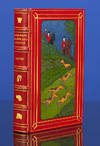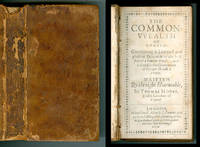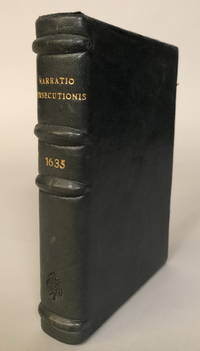![Succenturiatus anatomicus. Continens commentaria in Hippocratem, de capitis Vulneribus. Additae in aliquot Capita libri VIII.C.Celsi Explicationes. [Et :] A. Cornelii Celsi De re Medica liber octavus.](https://d3525k1ryd2155.cloudfront.net/h/359/910/1497910359.0.m.jpg)
Succenturiatus anatomicus. Continens commentaria in Hippocratem, de capitis Vulneribus. Additae in aliquot Capita libri VIII.C.Celsi Explicationes. [Et :] A. Cornelii Celsi De re Medica liber octavus.
by PAAW, Petrus
- Used
- Hardcover
- first
- Condition
- See description
- Seller
-
Paris, France
Payment Methods Accepted
About This Item
2 parts bound in 1 volume 4to [200 x 140 mm] of: I/ (12) ll. including the title printed in red and black and the portrait of the author at the back, 270 pp., 1 folding frontispiece and 34 engravings in the text; II/ (1) title, 128 pp., 2 folding plates and 25 engravings in the text. Small wormhole in pp. 9 to 55 of the second text, 2 handwritten ex libris on the title-page, old handwritten note in the margin of p. 177. Bound in contemporary full limp overlapping vellum, remains of leather ties, flat spine with handwritten title. Contemporary binding.
Rare original edition of paaw's comments on Hippocrates and Celsius' works concerning the head wounds.
Graesse, Trésor de livres rares, V, p. 99.
The Renaissance humanism is marked by a sudden infatuation for anatomy. The first anatomists had to overcome great difficulties. The anatomic lecture halls were slowly built, in Padua in 1490, in Basel in 1588, in Paris in 1608.
The dissection of corpses exposed to important sanctions from the civil and religious authorities.
" Pierre Paaw, a skilful anatomist, was born in Amsterdam in 1564. In 1580, he went to study medicine in Leiden. After four years, he came to France, where he stayed quite a long time in Paris and Orleans. Then he went to Denmark. He was in Rostock in 1587, and was admitted as doctor in medicine, and started to teach anatomy. Little time after, he travelled to Italy in order to hear the lecture of Fabrizio d'Aquapendente. His father's death obliged him after three months to go back to his homeland ; he went back to Leiden, where, during twenty-eight years, he practised the art of healing with a lot of success, and taught brilliantly anatomy and botanic. He is the one who got the public lecture hall of anatomy of Leiden to be built. Paaw died in 1617. His works contain quite a large number of interesting observations. " (Dezeimeris, Dictionnaire historique de la médecine ancienne et moderne, III, p. 659)
The work contains the author's comments on Hippocrates and Celsius works. The first text is written in Greek and Latin. Born in 460 BC, Hippocrates was considered as the greatest scholar of his time; he founded medicine. His medical practice was based on the observation he made of the human body.
The work is richly illustrated with 59 copper engravings in the text very finely executed, representing the skull anatomy (with the teeth), trepannings and surgical instruments. Besides the illustration contains a portrait of the autor and 2 folding plates showing an entire human skeleton and a skull.
But the present work is famous above all for its folding frontispiece engraved by Andries Jacobsz Stock after Jacob de Gheyn (1565-1629) and that represents the well-known scene of the dissection lesson provided by Paaw in the lecture hall of Leiden that he got to be built.
A very attractive copy of this rare original edition, pure and wide-margined, preserved in its contemporary limp overlapping vellum, complete with the folding frontispiece that is often missing.
Provenance: from the Bibliotheca Celeberrimae Cadomensis Academiae with engraved ex libris on the paste down of the binding; copy of the famous Hellenist Jean-François Boissonade de Fontarabie (1774-1857) with handwritten ex libris on the title.
Only 1 copy is recorded on the public market since 1975, the copy bound in " rebacked " vellum sold by Sotheby's London on April 2nd 1985 for £ 1,150 (lot 396).
FR
Lugduni Batavorum [Leyde], Iodocum a Colster, 1616.
2 parties reliées en 1 volume in-4 de: I/ (12) ff. y compris le titre imprimé en rouge et noir et le portrait de l'auteur au verso, 270 pp., 1 frontispice dépliant et 34 gravures dans le texte; II/ (1) f. de titre, 128 pp., 2 planches dépliantes et 25 gravures dans le texte. Petit trou de vers dans les pp. 9 à 55 du second texte, 2 ex libris manuscrits sur le titre, note manuscrite ancienne dans la marge de la p. 177. Relié en plein vélin souple à recouvrement de l'époque, restes de liens de cuir, dos lisse avec le titre manuscrit. Reliure de l'époque.
200 x 140 mm.
Rare édition originale des commentaires de paaw sur les travaux d'Hippocrate et de Celsus à propos des blessures à la tète.
Graesse, Trésor de livres rares, V, p. 99 ;
L'humanisme de la Renaissance est marqué par un soudain engouement pour l'anatomie. Les premiers anatomistes eurent à surmonter de grandes difficultés. Les amphithéâtres d'anatomie s'édifièrent lentement, à Padoue en 1490, à Bâle en 1588, à Paris en 1608.
La dissection de cadavres humains exposait à de graves sanctions de la part des autorités civiles et religieuses.
" Pierre Paaw, habile anatomiste, naquit à Amsterdam en 1564. En 1580, il alla étudier la médecine à Leyde. Au bout de quatre ans, il vint en France, où il demeura assez longtemps à Paris et à Orléans. Il passa ensuite en Danemarck. Il fut à Rostock en 1587, s'y fit recevoir docteur en médecine, et commença à enseigner l'anatomie. Peu après il fit un voyage en Italie pour aller entendre à Padoue les leçons de Fabrizio d'Aquapendente. La mort de son père l'obligea, au bout de trois mois, de rentrer dans sa patrie ; il revint à Leyde, où, pendant vingt-huit ans, il pratiqua l'art de guérir avec beaucoup de succès, et professa avec éclat l'anatomie et la botanique. C'est lui qui fit bâtir l'amphithéâtre public d'anatomie de Leyde. Paaw mourut en 1617. Ses ouvrages contiennent un assez grand nombre d'observations intéressantes. " (Dezeimeris, Dictionnaire historique de la médecine ancienne et moderne, III, p. 659).
L'ouvrage contient les commentaires de l'auteur sur les travaux d'Hippocrate et sur ceux de Celsus. Le premier texte est rédigé en grec et en latin.
Né en 460 avant Jésus Christ, Hippocrate, considéré comme le plus grand savant de son temps, fonda la médecine. Il reposait sa pratique médicale sur l'observation qu'il effectuait du corps humain.
L'ouvrage est richement illustré de 59 gravures sur cuivre dans le texte très finement exécutées représentant l'anatomie du crâne (avec les dents), des trépanations et des instruments chirurgicaux. L'illustration comporte en outre un portait de l'auteur et 2 planches dépliantes qui montrent un squelette humain entier et un crâne.
Mais le présent ouvrage est avant tout célèbre pour son frontispice dépliantgravé par Andries Jacobsz Stock d'après Jacob de Gheyn (1565-1629) et qui représente la fameuse scène de la leçon de dissection donnée par Paaw dans l'amphithéâtre de Leyde qu'il avait lui-même fait bâtir.
Très séduisant exemplaire de cette rare édition originale, pur et grand de marges, conservé dans son vélin souple de l'époque à recouvrement, bien complet du frontispice dépliant qui manque souvent.
Provenance : de la Bibliotheca Celeberrimae Cadomensis Academiae avec ex libris gravé au contreplat de la reliure ; exemplaire du célèbre helléniste Jean-François Boissonade de Fontarabie (1774-1857) avec ex libris manuscrit sur le titre.
Seul 1 exemplaire est répertorié sur l'ensemble du marché des ventes françaises et internationales depuis 1975, l'exemplaire relié en vélin avec le dos refait (" rebacked ") vendu par Sotheby's Londres le 2 avril 1985 pour 1150 £ (lot 396).
Reviews
(Log in or Create an Account first!)
Details
- Bookseller
- LIBRAIRIE CAMILLE SOURGET
(FR)
- Bookseller's Inventory #
- BIBLIO-LIVE-4-16
- Title
- Succenturiatus anatomicus. Continens commentaria in Hippocratem, de capitis Vulneribus. Additae in aliquot Capita libri VIII.C.Celsi Explicationes. [Et :] A. Cornelii Celsi De re Medica liber octavus.
- Author
- PAAW, Petrus
- Book Condition
- Used
- Quantity Available
- 1
- Binding
- Hardcover
- Weight
- 0.00 lbs
Terms of Sale
LIBRAIRIE CAMILLE SOURGET
About the Seller
LIBRAIRIE CAMILLE SOURGET
About LIBRAIRIE CAMILLE SOURGET
Glossary
Some terminology that may be used in this description includes:
- Vellum
- Vellum is a sheet of specialty prepared skin of lamb, calf, or goat kid used for binding a book or for printing and writing. ...
- Spine
- The outer portion of a book which covers the actual binding. The spine usually faces outward when a book is placed on a shelf....
- Verso
- The page bound on the left side of a book, opposite to the recto page.
Frequently asked questions
Also Recommended
-

Save 10% on every purchase!
Join the Bibliophiles’ Club and start saving 10% on every book.
$29.95 / Year











